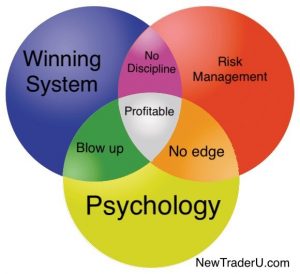Profitable trading is simply making more money on your winning trades than you lose on your unprofitable trades. Profitable trading is not about being perfect and making money on every trade. It is not about predicting the future, making a great call, or any one big trade, it is all about the math.
Here is the real path to profitable trading.
You need a quantified trading system with an edge that creates only four things: a big win, a small win, a break even trade, or a small loss. If you have this type of process then you will make money over the long term as your edge plays out. The most important part of the process is eliminating big losses from your system.
The purpose of backtesting and historical chart studies is to develop a process of entries and exits that creates the big wins and the small losses. Stop losses keep losses small and trailing stops can maximize winning trades.
The psychology of execution of a trading system is one of the most important aspects of trading. The trader is the weakest link in any system. Ego, stress, and emotions can stop a trader from following their system with discipline and perseverance.
Position sizing is a crucial part of keeping losses small. The size of your trades must be based on the maximum loss you would experience if your stop loss is hit. A loss of 1% to 2% of total trading capital is a safe level to manage. Position sizing of 10% of your trading capital is generally safe in non-leveraged markets. Volatility and trading range is the best guide to a trade size, you may be able to trade a 100% positions size in the SPY ETF at times and other times only a 1% size in stock options.
The risk has to be worth the reward. On entry, the profit target should be at least twice as much as the stop loss placement. Creating good risk/reward ratios at entry is a primary key to profitable trading. The higher the reward to risk ratio, the less winning percentage it takes to be a profitable trader.
You must know your positive expectancy as a trader, it is defined as how much money, on average, you can expect to earn for every dollar you risk.
Calculate your profit factor, it is calculated as the gross profit divided by the gross loss (including any commissions and slippage) for a full trading period. This metric of performance shows the amount of profit per unit of risk and values greater than one indicate a system is profitable.
Profitable trading step by step
- Do backtests and historical chart studies.
- Develop a trading strategy with an edge.
- Define exactly entry and exit parameters.
- Define position sizing based on volatility and trading range.
- Take trading signal entries.
- Cut losing trades short when a stop loss is triggered.
- Let winning trades run until a trailing stop is triggered or a profit target is reached.
- Manage total risk exposure.
- Trade the system with discipline and perseverance over the long term.
